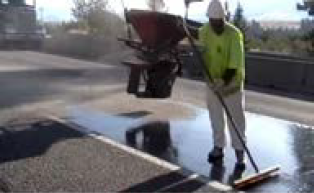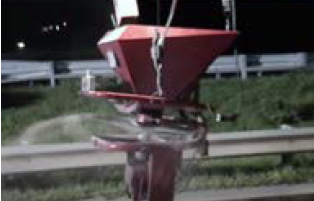U.S. Department of Transportation
Federal Highway Administration
1200 New Jersey Avenue, SE
Washington, DC 20590
202-366-4000
Once HFST has been selected for use, it is appropriate to evaluate site specific specifications and implementation controls. This section will help answer the following questions:
HFST can be implemented using any of three main application methods: fully-automated, semi-automated, and manual. The preferred application method varies and can depend on the size of the project, the number of installations within the contract, and specific project needs.
For instance, manual installation may be used for small spot-treatments while a fully-automated process might be used for larger systemic contracts consisting of numerous sites. Most transportation agencies contract out their HFST installations, which is done primarily to avoid purchasing HFST-specific equipment.
This section briefly describes the differences between manual, semi-automated, and fully automated application methods.
Manual HFST application, shown in Figure 6, is ideal for small spot locations of 200 sq. yd. or less. For a completely manual application, the binder components and any additives that affect curing time are manually mixed on site in buckets. Workers pour the mixed binder onto the prepared surface and spread it using squeegees. Next, the aggregate is spread on top of the binder. There is no preferred method to spread the aggregate, but the binder must be completely covered.

While the manual application method is ideal for keeping costs low on small spot-treatments, this method has a few drawbacks. Working under live traffic conditions increases safety risks by prolonging workers' exposure to traffic. Further, given the opportunity for human error and inconsistency, quality and uniformity in manually applied treatments are a concern. In addition, the prolong presence of work zone can potentially cause secondary crashes.
When agencies plan to apply HFST at several locations or on a long roadway section, the semi-automated and fully-automated approaches may be preferred as they provide a higher-quality application at a lessexpensive cost point.
Semi-automated HFST application involves a combination of manual labor and machine-aided application. The exact combination of manual and automated application largely depends on the type of application truck. The simplest trucks are equipped with a wide spreader bar that distributes either the aggregate or the binder. More expensive trucks are equipped with any combination of a mixing machine, binder spreader, and aggregate spreader.

The Kansas Department of Transportation (KDOT) and the Montana Department of Transportation (MDT) both use trucks that mix the binder components and additive (proportional to the ambient temperature) to ensure proper curing time. The truck then pours the binder out a spigot located directly behind the truck (Figure 6) as the truck slowly drives down the lane. Workers use squeegees to evenly spread the binder behind the truck. A 15-20 ft. arm stretching behind the truck distributes the aggregate onto the recently squeegeed binder (Figure 7).
This semi-automatic method allows the roadway surface to be covered more quickly than manual application methods and the onboard mixer ensures a quality binder that will cure at current temperatures. On larger projects, the reduced labor hours can offset the cost of the additional equipment resulting in a lower installation unit cost. There are tradeoffs associated with increased labor using the manual method versus the need and cost for more equipment using the automated method; the semiautomatic method falls somewhere in between.
Fully-automated HFST application, shown in Figure 8, typically involves a truck customized to mechanically mix each component of the binder, in accordance with the current ambient or surface temperature, and apply a consistent layer of the binder and aggregate to the pavement surface, without any manual squeegeeing or spreading. The truck contains the binder and aggregate in large bulk containers on its chasee and can be customized to the intended width and thickness of the treatment. It can install as much as 2600 sq. yd. in 12 foot widths before the need to refill. This application method minimizes lane closures due to quick installation time, reduces the number of workers on the roadway, ensures a more quality application, and reduces overall project costs on large systemic installations.27



Manual vs. Fully-Automated Comparison28
At an infrastructure maintenance symposium held in Columbus, Ohio, a manual application of HFST was compared with a fully automated application. The manual application used a crew of 5 with bucket and rubber squeegees. The fully-automated HFST process installed 350 sq. yd. of full lane width in approximately 8 minutes, while the manual application installed 100 sq. yd. in 15 minutes, exhibiting that the fully-automated process can be 6 times as faster as the manual process. Benefits of using the fully-automated processes include:
HFST is best applied on a clean and dry surface that is free of debris and standing or accumulated water throughout installation. The ambient temperature must be above the binding material's manufacturer recommendations. In general, ambient temperatures need to be between 50 to 100 degrees Fahrenheit, preferably between 60 to 95 degrees Fahrenheit. Temperatures outside this range may affect working time for installing or curing the material as well as the final strength of the product. Many polymers, such as epoxy resins, will not reach their fully designed strengths when cured at lower temperatures. This can result in early loss of aggregates and premature wear in the wheel path. However, some manufacturers have developed binders or binder additives that enable the binder to perform well at lower temperatures.29 Always refer to the manufacturer's instructions to ensure the best quality performance of each application.
Detailed HFST specifications for eight States and the United Kingdom Highway Agency can be found on ATSSA's High Friction Surface website.30 Additional provisional high friction surface treatment standard specifications can be found in AASHTO's Standard Specifications for Transportation Materials and Methods of Sampling and Testing, 35th Edition and AASHTO Provisional Standards, 2015 Edition.31
Several leading HFST implementation States shared the lessons they learned over copious installations. Caltrans found that if the aggregate is unevenly applied to the binder, the binder might intersperse into the aggregate at different rates, creating a slight rumble in the roadway surface. Excess materials need to be removed soon after application to provide a uniform surface.
North Carolina Department of Transportation (NCDOT) and Colorado Department of Transportation (CDOT) discovered that a combination of two different issues occurring simultaneously caused the underlying asphalt pavement to delaminate. The first was associated with poorly draining pavement that trapped water underneath the HFST. The second was cracking of the underlying asphalt pavement that reflected through the HFST. Even though these issues caused the asphalt to delaminate, the HFST remained intact on the asphalt material.32
States also encountered problems when installing HFST on open-grade concrete. The HFST tends to sink into the gaps in the OGAC. To solve this, States applied two layers of HFST. The first layer filled gaps while the second layer provided the needed friction and ensured a good bond and service life.33 Double layers may also be used on roads where snow chains or studded tires are common.34
27 http://www.dbiservices.com/high-friction-surfacing-treatment. [ Return to note 27. ]
28 DBI Services HFST Automated Manual Comparison Video: https://www.youtube.com/watch?v=jetAFKWm-Vw. [ Return to note 28. ]
29 FHWA's High Friction Surface Treatments Frequently Asked Questions. Publication No. FHWA-CAI-14-019. [ Return to note 29. ]
30 http://www.highfrictionsurface.net. [ Return to note 30. ]
31 https://bookstore.transportation.org/item_details.aspx?id=2347. [ Return to note 31. ]
32 FHWA's High Friction Surface Treatments Frequently Asked Questions. Publication No. FHWA-CAI-14-019. [ Return to note 32. ]
33 Interview with Darrell Chambers and Robert Peterson, California Department of Transportation, conducted on November 25, 2014. [ Return to note 33. ]
34 FHWA's High Friction Surface Treatments Frequently Asked Questions. Publication No. FHWA-CAI-14-019. [ Return to note 34. ]
| < Previous | Table of Contents | Next > |
